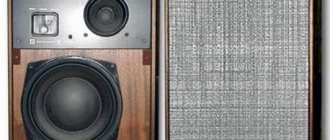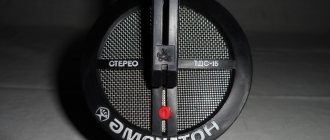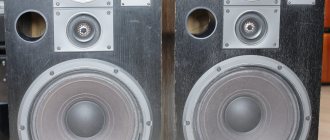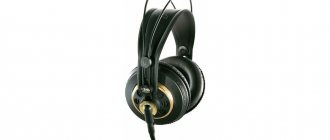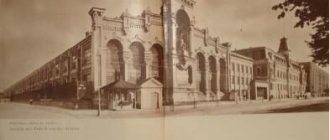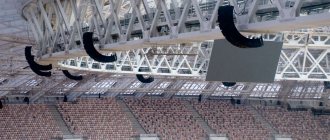Listening to AC Electronics 150 AC-001 after Hi-End acoustics
One of the largest acoustic systems in the Soviet Union was the high-class speakers Elektronika 150 AS-001. Of course, other speakers - Radiotekhnika S90 - gained great popularity, but this was clearly influenced by factors of cost and availability for sale.
Today it’s easy to find Radiotekhnika S90 speakers to listen to, but Elektronika 150 AC-001 may not be available in your city at all.
The main feature of the acoustics Electronics 150 AC-001 is a Hale emitter (acoustic transformer) in the high-frequency and mid-frequency sections. It covers the entire HF/MF range during playback.
In the lower section it is supplemented with an EBM concert speaker with a diameter of 20 cm. A 20 cm passive radiator was also used - in appearance it looks like another speaker, but does not have a magnet in its design and, accordingly, is not connected to the crossover.
Hale emitters are also found on foreign acoustics, but they are very expensive and therefore also rare. Usually these are fierce Hi-End products. What prevented Soviet industry from churning out and exporting tons of such Hale emitters abroad and receiving foreign currency for it is a mystery to me.
The acoustics have been completely restored by the owner to excellent condition. Hale's emitters had serviceable (in my opinion, even new) corrugated membranes made of dielectric film with a specially shaped conductor.
Expanded speaker corrugation
I listened to Elektronika 150 AS-001 version 2. In the second version, the Hale emitter is assembled with less quality - instead of a single milled piece of metal, a plate-type structure is used, and the membrane itself is smaller (8 cm high, instead of 12 cm in the first version).
The acoustics are quite large, but not bulky. It looks beautiful and impressive. The only change that the owner made was to decouple the Hale emitter from the body, removing its unique platform table with metal cone legs standing on the main body.
I didn’t take my own photos, I use them from the Internet
We connected Electronics 150 AC-001 to a high-level Hi-Fi amplifier Xindak XA6950.
This transistor device operates in pure class A, so it heats up quite noticeably during operation.
The source was a Yulong DA-100 DAC and a Sony CD 222ES player.
For the starting point of sound quality gradation before listening to the Electronics 150 AC-001, speaker systems, as I understand it, Hi-End level, Totem Acoustic Forest, were connected to the same setup.
I find it difficult to answer their retail price; Yandex search indicates a price of 384,000 rubles (~$7,000).
Aluminum Seas tweeter and its own woofer
I listened to Totem Acoustic Forest as a basis and then turned on the Soviet acoustic systems Elektronika 150 AS-001.
The first impressions that I received in the first few seconds can be described in the following words.
- The resolution has certainly dropped. But this is for my taste preferences. Go to a live concert - classical music or some kind of orchestral band - what you hear is real “live” resolution. It was at this level of resolution, “live”, that the Electronics 150 AS-001 sounded. Another thing is that I’m used to and love higher resolution, like the Totem Acoustic Forest, so that I can hear not only the voice, but also the entire anatomy of the vocalist/vocalist at a glance.
- There are even more sounds in the mid-frequency register. Of course, these sounds did not disappear anywhere on the Totem, but they were not accentuated. And excuse me, this is an acoustic guitar, how can you not accentuate it? The electronics of the 150 AC-001 just accentuated every sound of the strings of an acoustic guitar, their “film” creak against the fingers. From this I can say that the mid-frequency range appeared even richer thanks to the Hales.
Of course, Electronica 150 AC-001 is not at the level of Totems, it is lower, but it plays very well. The sound is soft. Not sweet, but soft, pleasant, you can listen to it tirelessly all day long.
I liked the way the orchestrations sounded - the wind instruments just sounded great.
The sound is clear, crisp, with good resolution - everything is perfectly audible.
The sound is pleasantly soft and large-scale - you feel the grandeur of the musical work, and the size of the speakers helps with this.
Localization and volume of instruments - at this point I would mark it as average, but the owner of these speakers completely disagrees with me. On the contrary, he believes that the main feature of these speakers is their large volume (a sense of three-dimensionality) and good localization. After Totems it doesn't seem so obvious to me. The owner claims that the Elektronika 150 AS-001 was listened to at too close a distance (about 2-2.5 meters), and the speakers in them are concert-type and require a larger volume as a room (listened to in a room around 9-11 meters) and then they sound even more more voluminous.
I had a reasonable question: why was it impossible in the USSR to mass-produce precisely these good-sounding speakers Elektronika 150 AS-001, and not the blockheads S90?
Acoustics of a good level of Hi-Fi class. Excellent display of high and mid frequencies, smoothly, without distortions. I also liked the low register, it plays well and clearly.
As for quibbles, it still seemed to me that the vocals were somewhat unlocalized, they did not come from a specific point, but in general. How important this is and to whom is a matter of personal preference. The tools are distributed well in space.
Soft, excellent sound with “live” (respectively average) resolution. I liked the acoustics, they were excellent. For example, it is even preferable to the top 4-way and at one time pioneering speakers Victor Zero 7, which cost 240,000 yen in 1979.
Victor Zero 7
But personally, I couldn’t keep these for myself, because my tastes lie in ultra-resolution and ultra-localization. Probably, to some extent, the Electronics 150 AC-001 are very similar to the magnificent Japanese acoustics Sony SS-G7 with corbocon speakers, created specifically for “live” resolution. The resolution of the Electronics 150 AC-001 is exactly the same as in the G7, but the scale and depth of the low frequencies still clearly belong to the Sony acoustics.
Sony SS-G7
In our market, Electronics 150 AC-001 is offered on average from 60 to probably 100,000 rubles, and I can’t vouch for a hundred thousand, but it’s normal to pay 60-70 for such a sound (for a used one). Just keep in mind that everything also depends on the condition and serviceability of the acoustics, because anything can be in excellent condition and at the level of expensively restored firewood. I listened to acoustics in excellent technical condition.
For me, based on the results of listening to the Electronics 150 AS-001, I was pleased to learn that the USSR really had a decent-sounding acoustic model that could well compete with foreign competitors.
Speakers Radiotehnika S30 characteristics
Hello! I have a couple of questions, but first things first. This means that the characteristics of the TDA7265 microcircuit are as follows: Supply voltage (recommended) ………. ±20V Supply voltage (max)………. ±25V Output power (8Ω, ±20V, THD = 10%)………. 25W (per channel) Output power (4Ohm, ±16V, THD = 10%)………. 25W (per channel) Output power (8 Ohm, ±20V, THD = 1%) ………. 20W (per channel) Output power (4 Ohm, ±16V, THD = 1%)………. 20W (per channel) Peak output current………. 4.5А Protection response temperature ……… 145°C I have two Radiotehnika S-30 speakers with the following parameters: Maximum power according to the product data sheet – 30 W. Nominal power – about 10 W. Peak power – up to 300 W. Reproducible frequency spectrum – from 50 Hz to 18 kHz.Operating – 50-16000 Hz.Nomin. resistance – 4 Ohms. Minimum impedance – 3.2 Ohms. Average sound. pressure - 1.2 Pa. Sensitivity - about 84 dB. Speaker for low and medium frequencies - 25 GDN-1-4 (equivalent to 10 GD-34). Speaker for high frequencies - 6 GDV-1-16 (equivalent to 3 GD- 2). I quote that I found something useful from the comments here https://radiostorage.net/784-usilitel-2×25-watt-na-tda7265.html and collected everything here: “As for the power of the transformer: I think 70-100 Watt should be enough for this circuit,” “Also in the datasheet, as an example, the harmonic distortion values are given for a 4 ohm load and +/-16V power supply. You can use this supply voltage, or you can try a higher one; with a higher supply voltage and a load of 4 ohms, there is a possibility that at high volumes the protection in the microcircuit will be triggered.” “The secondary windings of the transformer should produce at least 3 Amps, preferably 4 Amps, for this amplifier in order to power this circuit at a voltage of 12.5V and get the expected output from it.” “The TDA7265 chip will not produce 2x50W at 4 Ohms because it has built-in output current protection (Output Peak Current Internally limited), at 4 Omah it is possible that you can squeeze out 30-35 watts. In the case of using a 4 Ohm load, you need to worry about a reliable heat sink for the microcircuit, and the power supply should not be too high - 15-18 V per arm. "" To avoid burning the acoustics during the setup process (anything can happen), connect the ULF fuses in series to the output 0.5-1 Ampere, this will help if something goes wrong. Then, after adjustment, the fuses can either be removed or set to a higher current - 2-2.5A.” I wound the toroid with a calculated power of 100-120 W, and wound the secondary with an increased voltage so that later, after the answers here, I can unwind the excess. Question one
, how many optimal alternating volts are needed for the transformer and do you indicate the voltage values for 4 Ohms with or without a load on the transformer?
Because if the voltage values without load are HIGHER than with load, take this into account, and nowhere is the value clearly stated, so please tell me. Question two
, follow the link to the filter with a bridge here: https://forum.radiostorage.net/download/file.php?id=7&sid=89185dfa0337164ba6c8f1594178f1ca What capacitors are used for audio, film or ceramics?
And how many microfarads should you set the electrolytes to? What is the amperage of the fuse for the mains input? Question three[/b
]: What is the area of the radiator for the microcircuit? I ask you to answer these three questions.
Soviet HI-FI and its creators: passions according to Hale - Electronics 150AC - 001
This post will talk about an acoustic system created in the bowels of the Leningrad VNIIRPA in the late 80s and produced in small series at the Ferropribor plant. The fate of this Soviet development, despite its significance and revolutionary nature for domestic electroacoustics, did not turn out in the best way. The serial production of St. Petersburg speakers was influenced by the era in which they went into production, namely 1991. As I will never tire of repeating, history does not recognize the subjunctive mood, but, probably, if not for the collapse of the Soviet system, this acoustics would have surpassed various S-90s and Cleavers in popularity.
This development attracted my attention for several reasons: high-quality processing of the American prototype (except for the concept, nothing was copied), the use of a hale emitter with a wide frequency range as a mid-HF link, the use of a “closed box” with a passive radiator to implement the low-frequency section, impressive characteristics.
Create cannot be cloned
As I noted earlier, in the late 80s, “industrial espionage” activities on consumer goods intensified. In other words, because of the rotting Iron Curtain, Soviet officials from technical departments were dragging more and more suitable equipment as samples for study and copying. At the same time, the taste of spy officials was quite decent, so in 1987, the legend of American column construction ESS AMT 1 came to VNIIRPA for the needs.
ESS AMT 1
A characteristic feature of the imported sample is a powerful low-frequency section and a futuristic, large Hale emitter as a source of mid and high frequencies. Interestingly, in the USA ESS AMT 1 has been produced since 1973. Moreover, he was considered a true audiophile legend, possessing characteristics that were difficult to achieve not only in the 70s, but also in the 80s of the last century:
- Frequency range: 45 Hz – 24000 Hz (with frequency response unevenness ± 2 dB)
- THD (at SPL 90 dB):
- 600Hz: 0.5%
- 60Hz: 1%
- Resistance: 4 ohms
- Rated power: 120W
- LF: 250 mm, cone (corn paper)
- HF: Hale emitter (electrostatic type)
- Filter cutoff frequency: 600 Hz
- Dimensions (HxWxD): 787x362x362 mm
At the destination, i.e.
The American miracle acoustics entered VNIIRPA only in 1989 (judging by information from one of the developers voiced on the rt20.mybb2.ru forum). A quick study of the American model shows that in some respects it is inferior to similar acoustics already being developed at VNIIRPA since 1987. The design of the experimental speaker is also based on the combination of the low-frequency section with a Hale radiator, but unlike the American model, the low-frequency section is made in the form of a closed box with a passive radiator.
According to a number of information, a detailed comparison of measurements in the anechoic chamber of the Soviet prototype and American serial acoustics leads to the conclusion that it makes no sense to copy outright. A decision was made to maintain our own design and borrow only some design features of the Hale emitter and filter circuitry from the “American”.
In fairness, it should be noted that the starting point for the new Soviet speaker was also the ESS AMT 1. It was with the interest of Soviet engineers in this product of “enemy” electroacoustics that the epic with the development of speakers based on Hale began and it was for this reason that it was launched in 1987 year was brought to the USSR as a sample.
High fidelity prototype
We can say that the development of such acoustics in this difficult time for Soviet instrument making is already a kind of feat. Prototyping of the new model was completed in 1989.
Initially, 2 samples were tested, namely 150 AC AT-001 (100 liters) and 150 AC AT-002 (70 liters).
In the second alternative, the passive radiator was located on the rear wall of the housing. Due to a number of obvious shortcomings, the compromise 70-liter version was not put into production. I was not able to see control measurements, but it is obvious that the low-frequency section housing with a smaller volume was worse. The prototype of the main version (001) turned out to be surprisingly successful, which promised a successful future for the new speakers. The main innovations of the new development concerned the Hale emitter. The membrane of Soviet speakers was made of polyamide, which today is the main material for creating ribbon and electrostatic emitters due to its unique thermodynamic properties. The membrane thickness was 14 microns.
An original feature of the tape driver design was the use of the so-called. “crossbars” to which the edges of the membrane folds were attached. Thus, the edges of the “accordion” bends remained static, and the movement of the membrane occurred deep in the folds, which made it possible to maintain a stable shape and eliminate harmful resonant vibrations without compromising the radiation.
The use of this innovation made it possible to obtain a smoother frequency response and a small number of resonances in the audible spectrum, compared to the American source.
The use of a closed box in the low-frequency section also significantly reduced cabinet resonances and nonlinear distortions, and also significantly affected the subjective parameters of fidelity. In general, the characteristics of the later prototypes were as follows:
- Frequency range: 40 – 25000 Hz with frequency response unevenness in the frequency range 100-8000 Hz: ±1.5 dB
- Sensitivity: 91 dB (0.71 Pa/√W)
- SOI at 90 dB SPL:
- 250 – 1000 Hz: 1.2%
- 1000 – 2000 Hz: 0.9%
- 2000 – 8000 Hz: 0.6%
- Hale Emitter Impedance: 11 Ohm
- Bass section resistance: 8 ohms
- Minimum impedance value: 6.4 ohms
- Long-term power: 150 W
The circuitry and design of the filters can be judged from the materials presented below:
The speaker prototype was superior to the American model, both in terms of power and level of distortion. Also, the new Soviet speaker had a more uniform frequency response, which could not but please the developers.
Serial problems
However, the prototype often differs from the production model. Mass customization often involves the use of different technological techniques than those used in laboratories and prototyping, which inevitably leads to deterioration in performance.
Preparations for serial production of 150AS-001 were carried out at the Ferropribor plant. The start of production was planned in 1990. Opinions differ regarding the start of production; some former employees of Ferropribor claim that this was the case, others write that the first series was released only in 1991. The reference materials indicate the year 1991.
The technology for creating the Hale emitter at the factory was slightly changed, which resulted in a change in characteristics significant for sound, which in production samples were noticeably inferior to the prototype (data from ldsound.ru):
- Frequency range: 40 (-3 dB) – 25000 Hz
- Sensitivity: 91 dB (0.71 Pa/√W)
- Frequency response unevenness in the frequency range 100-8000 Hz: ±4 dB
- Harmonic distortion at 90 dB sound pressure level in the frequency range:
- 250 – 1000 Hz: 2%
- 1000 – 2000 Hz: 1.5%
- 2000 – 8000 Hz: 1%
- Resistance: 8 ohms
- Minimum impedance value: 6.4 ohms
- Long-term power: 150 W
As the economic situation of the enterprise worsened, 2 more versions of the AC were released, the task of each of the upgrades was to simplify and reduce the cost of the design.
Despite the fact that the passport data of the acoustics did not change, many people familiar with the development and production claim that the later series were many times inferior to the first, both in the level of distortion and frequency response uniformity, and in the quality of the filters. The differences between the series were mainly in the design features of the Hale emitters, its size and frequency characteristics and woofers. There is information about the so-called. “double Hales”, apparently, are the tweeters of the Elektronika 150 AS-001 early series before modernization, and the “one-and-a-half” and “single” tweeters of later, cheaper editions of the speakers. Below are the differences in the frequency response of “double” (red) and “one and a half” (blue) drivers:
More detailed measurements of the Electronics 150AC-001 emitters can be found at the link.
In the so-called The third version of Electronics 150 AS-001, according to one of the developers, uses different low-frequency drivers.
It is also known that at the end of 1991, the developers of Elektronika 150AS-001 from VNIIRPA visited the plant to evaluate the serial version of the speaker. A comparative audition of the prototype from the research institute and the serial version of the acoustics was even organized. Based on the listening results, the developers found the sound of the factory version to be unsatisfactory, and a corresponding report was drawn up.
At the same time, it is known that the release of “rationalized” versions of the speakers continued. This probably happened due to the fact that, even despite the deterioration of objective characteristics, it was superior to almost all power analogues produced at that time in the country.
Bottom line
The history of the development of this speaker demonstrates that when creating Soviet technology, blind copying of Western models was not always used.
It becomes clear that the independent developments of Soviet engineers were sometimes superior to their foreign counterparts. In addition, it illustrates the so-called “draconian rationalization”, which often harmed the quality of products in favor of manufacturability, cost reduction and increased production speed. Photos used: ldsound.ru
Jeans
Our catalog presents a wide range of high-fidelity acoustic systems, including speakers with Hale drivers.

